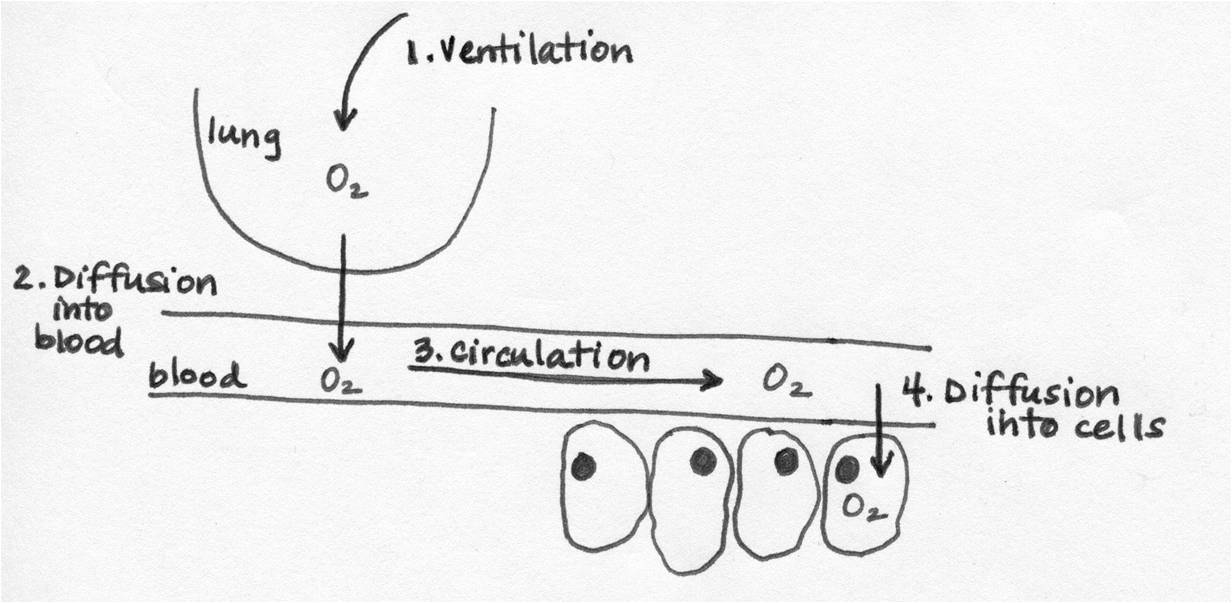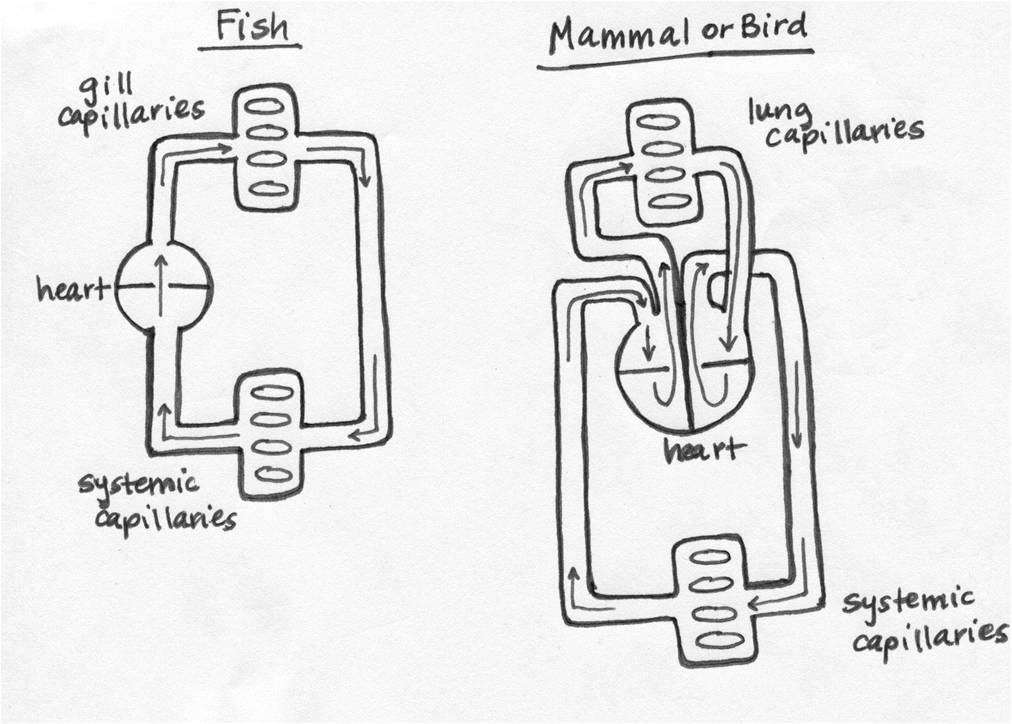CHAPTER SUMMARY
39.1 RESPIRATION AND CIRCULATION DEPEND ON DIFFUSION OVER SHORT DISTANCES AND BULK FLOW OVER LONG DISTANCES.
- Diffusion is effective only over short distances and requires large exchange surface areas with thin barriers.
- Ventilation and circulation provide bulk transport over long distances.
- Oxygen is delivered to tissues in four steps: (1) bulk flow of water or air past the respiratory surface (gills and lungs); (2) diffusion of O2 across the respiratory surface into the circulatory system; (3) bulk flow through the circulatory system; and (4) diffusion of O2 into tissues and cells.
39.2 RESPIRATION PROVIDES OXYGEN AND ELIMINATES CARBON DIOXIDE IN SUPPORT OF CELLULAR METABOLISM.
- Many aquatic animals exchange respiratory gases with water through gills.
- Countercurrent flow of water relative to blood in gills enhances O2 extraction from water.
- Terrestrial animals breathe air by means of internal tracheae or lungs.
- Terrestrial vertebrates inflate and deflate their lungs by bidirectional tidal ventilation driven by changes in pressure.
- A unidirectional flow of air maximizes O2 uptake by bird lungs.
- Both the voluntary and involuntary nervous systems control breathing.
39.3 RED BLOOD CELLS PRODUCE HEMOGLOBIN, GREATLY INCREASING THE AMOUNT OF OXYGEN TRANSPORTED BY THE BLOOD.
- Hemoglobin greatly increases the transport capacity of O2 in the blood.
- Red blood cells contain hemoglobin with iron-containing heme groups that reversibly bind and release O2.
- A sigmoidal O2-dissociation curve describes the change in the binding affinity of hemoglobin for O2 with changes in partial pressure. The shape of the curve results from cooperative binding of O2 by hemoglobin.
- Myoglobin binds and stores O2 in muscle cells, increasing the delivery of O2 to muscle mitochondria for activity in general and in marine mammals for diving.
- Fetal hemoglobin is expressed by the mammalian fetus to allow O2 uptake from the mother’s blood.
- The affinity of hemoglobin for O2 is affected by pH and CO2.
39.4 CIRCULATORY SYSTEMS HAVE DIFFERENT-SIZED VESSELS THAT FACILITATE BULK FLOW AND DIFFUSION.
- The fluid in a closed circulatory system travels through a set of internal vessels, moved by a pump, the heart. The fluid in an open circulatory system moves through only a few vessels and is mostly contained within the animal’s body cavity.
- Resistance to blood flow is most strongly controlled by vessel diameter.
- Arteries are thick-walled vessels that contain elastic fibers for support against pressure.
- Arterioles control blood flow within the body by changing their resistance through contraction and relaxation of the smooth muscle in their walls.
- Capillaries are small-diameter, thin-walled vessels that facilitate diffusion of O2 and CO2.
- Veins are thin-walled vessels that return blood to the heart under low pressure.
- Fluids, gases, and other compounds move across capillary walls by diffusion, filtration, and osmosis. In vertebrates, some fluid is returned to the bloodstream by the lymphatic system.
39.5 THE EVOLUTION OF ANIMAL HEARTS REFLECTS SELECTION FOR A HIGH METABOLIC RATE, ACHIEVED BY INCREASING THE DELIVERY OF OXYGEN TO METABOLICALLY ACTIVE CELLS.
- Birds and mammals have a separate pulmonary circulation, from the heart to the lungs, and systemic circulation, from the heart to the rest of the body.
- Fish have two-chambered hearts and a single circulatory path.
- Amphibians and reptiles have three-chambered hearts and a partially divided circulatory path.
- Birds and mammals have four-chambered hearts and fully divided pulmonary and systemic circulations to enhance O2 uptake and delivery to metabolizing tissues.
- One-way valves control blood flow through the heart.
- The cardiac cycle has discrete filling (diastole) and emptying (systole) phases.
- Cardiac muscle cells are electrically connected, allowing them to contract in synchrony as a unified heart beat.
- Contraction of the heart is controlled by signals from pacemaker cells of the sinoatrial and atrioventricular nodes, transmitted by electrical conducting fibers to the ventricles.
- The vertebrate autonomic nervous system regulates the heart’s cardiac output by changes in heart rate and stroke volume.
Self-Assessment Question 1
Diagram the four basic steps of O2 transport from an animal’s respiratory medium (air or water) to its cells.
Show Model Answer
Model Answer:

Self-Assessment Question 2
For an aquatic animal, describe what features of its gills favor diffusion of O2 and CO2.
Show Model Answer
Model Answer:
Gills are composed of stacks of lamellae, each made up of a thin layer of flattened epithelial cells. The lamellae provide both a large surface area for gas exchange and a short distance for the diffusion of gases between the blood of the aquatic animal and the passing water.
Self-Assessment Question 3
Name two differences in the physical properties of water and air that affect gas exchange in aquatic versus terrestrial animals.
Show Model Answer
Model Answer:
Aquatic animals must be very efficient at extracting oxygen from the water because the oxygen content in water is much lower than in air, and water is more viscous and dense than air, so more energy is required to move water by bulk flow during ventilation.
Self-Assessment Question 4
Explain how the tracheal respiratory system of insects enables high metabolic rates.
Show Model Answer
Model Answer:
Since the air tubes of an insect’s tracheal system are highly branched, each of its body cells is in close proximity to the tracheal system. This allows for rapid diffusion of oxygen from the air in the trachea directly into the body cells of the insect. There is no respiratory surface or circulatory system.
Self-Assessment Question 5
Explain how gill respiration is facilitated by unidirectional water flow, whereas lung ventilation can depend on bidirectional airflow.
Show Model Answer
Model Answer:
Gill respiration maximizes the efficiency of gas exchange by utilizing unidirectional water flow. Because water is pumped across the gills in one direction, the supply of oxygen is continuous and uninterrupted. This efficient system allows gill-breathers to extract sufficient oxygen from water, even though its oxygen content is much lower than air. In contrast, the bidirectional airflow of the lungs is less efficient because oxygen-rich air mixes with oxygen-poor air during ventilation. Lung ventilation can utilize bidirectional airflow despite its suboptimal capacity for gas exchange because the oxygen content of air is higher than that of water and the energetic cost of moving air by bulk flow is lower than for water (since air is less dense than water). The ventilation rate can be increased to deliver more oxygen as necessary without an enormous energetic expense to the organism.
Self-Assessment Question 6
Describe the pressure changes that are needed to draw air into the lungs and to expel air out of the lungs.
Show Model Answer
Model Answer:
During inhalation, the volume of the thoracic cavity is increased by contraction of the diaphragm. This increase in volume creates negative pressure inside the lungs that draws air into the lungs. During exhalation, the volume of the thoracic cavity is decreased by relaxation of the diaphragm. This decrease in volume creates positive pressure, expelling air out of the lungs.
Self-Assessment Question 7
Explain how cooperative binding by hemoglobin facilitates O2 uptake into blood.
Show Model Answer
Model Answer:
Once hemoglobin binds one molecule of O2, its affinity for binding additional O2 molecules dramatically increases. This cooperative binding maximizes uptake of O2 in areas of high oxygen content and allows for rapid saturation of O2 binding sites in hemoglobin before the blood leaves the capillaries surrounding the alveoli of the lungs.
Self-Assessment Question 8
Explain how the branching of larger arteries into many smaller vessels affects the rate of and resistance to blood flow in the smaller vessels.
Show Model Answer
Model Answer:
Since resistance to blood flow is proportional to 1/r4 (where r is the radius of the blood vessel), as arteries branch into smaller vessels, the resistance to blood flow increases. The increase in resistance causes a proportional decrease in the rate of blood flow.
Self-Assessment Question 9
Diagram the path of blood flow through the heart, lungs, and body of a fish and of a mammal or bird.
Show Model Answer
Model Answer:

Self-Assessment Question 10
Describe two mechanisms by which the cardiac output of an animal’s heart can be adjusted and indicate which is more important for increasing cardiac output in mammals.
Show Model Answer
Model Answer:
Cardiac output can be adjusted by changing either how fast the heart pumps the blood (heart rate) or the amount of blood pumped through the heart in each cardiac cycle (stroke volume). Mammals, including humans, increase cardiac output mainly by increasing heart rate via signals from the nervous system, whereas fish typically increase stroke volume to increase cardiac output.